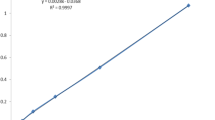Abstract
Pentavalent antimony compounds are expensive, toxic and drug resistance is prevalent, whereas the plant extract derivatives are safe. In the present study, the effect of methanolic and aqueous extracts of Eucalyptus camaldulensis on the promastigotes of Leishmania major was evaluated. The methanolic and aqueous extracts of E. camaldulensis leaves were prepared. The compounds were dried and powdered. Serial dilutions of the extracts and control drugs in phosphate buffer solution were prepared. The stationary phase promastigotes of L. major were incubated to the methanolic and aqueous extractions in vitro. Tartar emetic was used as the positive control drug. After 72 h of incubation the activity of the extracts was measured, using MTT method. The IC50 values (50 % inhibitory concentration) were 586.2 ± 47.6 and 1,108.6 ± 51.9 μg/ml for methanolic and aqueous extracts, respectively, whereas it was 32.5 ± 6.8 μg/ml for tartar emetic. The results indicated that the methanolic extract was more effective than aqueous extract, although there was no significant difference. The extracts were less effective as compared to the control drug. Further investigation is required to evaluate these extracts on clinical stage in macrophage-amastigote model.

Similar content being viewed by others
References
Adraiane L, Nery Zenilda B, de Morais F, Ana Carolina L, Amorim G, da S (2009) Study antileishmania activity of essential oil of Eucalyptus globulus and Eegenia uniflora in Leishmania amazonensis. In: 32 annual meeting of the Brazilian chemical society, Fortaleza, CE, Brazil
Ayepola OO, Adeniyi BA (2008) The antibacterial activity of leaf extracts of Eucalyptus camaldulensis (Myrtaceae). J Appl Sci Res 4:1410–1413
Babaee Khou L, Mohebali M, Niakan Lahiji PD, Mehrabi Tavana A (2007) The therapeutic effects of Eucalyptus, Myrtus, Ferula, Aretmisia, Allium and Urtica extracts against cutaneous leishmaniasis caused by Leishmanaia major in small white mice (out-bred). Hakim Res J 10:21–27
Batish DR, Singh HP, Kohli RK, Kaur S (2008) Eucalyptus essential oil as a natural pesticide. For Ecol Manag 256:2166–2174
Berg K, Zhai L, Chen M, Kharazmi A, Owen TC (1994) The use of a water-soluble formazan complex to quantitate the cell number and mitochondrial function of Leishmania major promastigotes. Parasitol Res 80:235–239
Desjeux P (2004) Leishmaniasis: current situation and new perspectives. Comp Immunol Microbiol Infect Dis 27:305–318
Doroodgar A, Arbabi M, Razavi MR, Mohebali M, Sadr F (2008) Treatment of cutaneous leishmaniasis in murine model by hydro alcoholic essence of Artemisia sieberi. Iran J Arthropod Borne Dis 2:42–47
Hadighi R, Boucher P, Khamesipour A, Meamar AR, Roy G, Ouellette M, Mohebali M (2007) Glucantime-resistant Leishmania tropica isolated from Iranian patient with cutaneous leishmaniasis are sensitive to alterative antileishmania drugs. Parasitol Res 101(5):1319–1322
Huber W, Koella JC (1993) A comparison of three methods of estimating EC50 in studies of drug resistance of malaria parasites. Acta Trop 55(4):257–261
Juergens UR, Stober M, Vetter H (1998) Inhibition of cytokine production and arachidonic acid metabolism by eucalyptol (1.8-cineole) in human blood monocytes in vitro. Eur J Med Res 3(11):508–510
Leung AY, Foster S (1996) Encyclopedia of common natural ingredients used in food, drugs, and cosmetics, 2nd edn. Willey, New York, pp 232–233
Mirzaie M, Nosratabadi SJ, Derakhshanfar A, Sharif I (2007) Antileishmanial activity of Peganum harmala extract on the in vitro growth of Leishmania major promastigotes in comparison to a trivalent antimony drug. Vet Arh 77:365–375
Monzote Fidalgo L, Montalvo Alvarez AM, Geigel LF, Perez Pineiro R, Suarez Navarro M, Rodraguez Cabrera H (2004) Effect of thiadiazine derivatives on intracellular amastigotes of Leishmania amazonensis. Mem Ins Oswaldo Cruz Rio de Janeiro 99:329–330
Mosmann T (1983) Rapid colorimetric assay for cellular growth and survival: application to proliferation and cytotoxicity assays. J Immunol Methods 65:55–63
Newall CA, Anderson LA, Phillipson JD (1996) Herbal medicines. A guide for health-care professionals. The Pharmaceutical Press, London
Pattnaik S, Subramanyam V, Kole C (1996) Antibacterial and antifungal activity of ten essential oils in vitro. Microbios 86:237
Roberts WL, Rainey PM (1993) Antileishmanial activity of sodium stibogluconate fractions. Antimicrob Agents Chemother 37:1842–1846
Sacks DL, Perkins PV (1984) Identification of an infective stage of Leishmania promastigotes. Science 223:1417–1419
Sereno D, Holzmuller P, Lemesre JL (2000) Efficacy of second line drugs on antimonyl-resistant amastigotes of Leishmania infantum. Acta Tropica 74:25–31
Sereno D, Cavaleyra M, Zemzoumi K, Maquaire S, Ouaissi A, Lemesre JL (1998) Axenically grown amastigotes of Leishmania infantum used as an in vitro model to investigate the pentavalent antimony mode of action. Antimicrob Agents Chemother 42:3097–3102
Sereno D, Guilvard E, Maquaire S, Cavaleyra M, Holzmuller P, Ouaissi A, Lemesre JL (2001) Experimental studies on the evolution of antimony-resistant phenotype during the in vitro life cycle of Leishmania infantum: implications for the spread of chemoresistance in endemic areas. Acta Trop 80:195–205
Sharma U, Velpandian T, Sharma P, Singh S (2009) Evaluation of anti-leishmanial activity of selected Indian plants known to have antimicrobial properties. Parasitol Res 105:1287–1293
Su V, King D, Woodrow I, McFadden G, Gleadow R (2008) Plasmodium falciparum growth is arrested by monoterpenes from eucalyptus oil. Flavour Fragr J 23:315–318
Verma Sh, Singh SP (2008) Current and future status of herbal medicines. Vet Word 1(11):347–350
Williams C, Espinosa OA, Montenegro H, Cubilla L, Capson TL, Ortega-Barria E, Romero LI (2003) Hydrosoluble formazan XTT: its application to natural products drug discovery for Leishmania. J Microbiol Methods 55:813–881
World Health Organization (2010) Control of the leishmaniasis. World Health Organ Tech Rep Ser 949:186
Acknowledgments
We thank the Leishmanianiasis Research Center of Kerman University of Medical Sciences and Health Services, due to undertaking the costs of this research and providing laboratory facilities.
Author information
Authors and Affiliations
Corresponding author
Rights and permissions
About this article
Cite this article
Nosratabadi, S.J., Sharifi, I., Sharififar, F. et al. In vitro antileishmanial activity of methanolic and aqueous extracts of Eucalyptus camaldulensis against Leishmania major . J Parasit Dis 39, 18–21 (2015). https://doi.org/10.1007/s12639-013-0377-3
Received:
Accepted:
Published:
Issue Date:
DOI: https://doi.org/10.1007/s12639-013-0377-3




